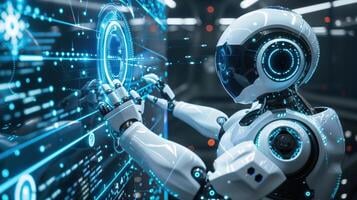The Future of Robotics in Industrial Automation
Advanced robotics integration in the field of industrial automation has led to profound transformation in the manufacturing and production processes....
ARTICLE
12/30/20242 min read


The Future of Robotics in Industrial Automation
Advanced robotics integration in the field of industrial automation has led to profound transformation in the manufacturing and production processes. Robots, though limited to repetitive tasks following pre-programmed functions under controlled environments, can, today, be developed based on artificial intelligence, ML, and sensor technologies and become adaptive, collaborative, with decision-making capabilities to handle independent situations.
Improve Efficiency and Precision
Industrial robots help boost efficiency through performing complex operations faster and more accurately. Industrial arms that use vision systems can sort, assemble, and inspect products to micron-level precision with very minimal waste and guarantee constant quality. This capability is crucial in automotive, electronics, and pharmaceuticals where minor errors could translate into major losses.
Collaborative robots, or cobots, are designed to work safely along side human beings while they enhance productivity by leveraging the strengths both of robotic precision and of human adaptability. With this partnership, businesses enjoy higher output rates but also have flexibility in production lines.
Decreasing Human Error While Maximizing Safety
One of the most critical advantages of robotics is the fact that it minimizes human error. Automated systems excel in performing repetitive tasks, with little or no chance of making mistakes due to fatigue or distraction. Furthermore, robots undertake hazardous tasks in environments that would otherwise be hazardous to human workers, such as exposure to harmful chemicals or extreme temperatures.
Predictive maintenance is another game-changing feature of robotics. Advanced robots with sensors monitor the machinery in real time and detect the issues before they cause equipment failure, thus reducing downtime and operational risks.
Challenges and Future Opportunities
Although robotics in industrial automation has many benefits, its adoption also presents challenges such as high initial costs, the need for skilled personnel, and ethical concerns regarding job displacement. Nonetheless, with advancing technology and decreasing costs, even small and medium-sized enterprises (SMEs) will be expected to adopt robotic solutions.
The future holds exciting possibilities with developments in autonomous systems, edge computing, and 5G connectivity. These technologies will enable smarter, more integrated robots capable of working seamlessly within industrial ecosystems.
By embracing robotics, industries can achieve enhanced sustainability, resilience, and efficiency, giving them a competitive edge in the globalizing and rapidly changing marketplace. This fusion of human ingenuity and robotic precision will reshape the future of industrial automation, paving the way for growth that is innovation-driven.
